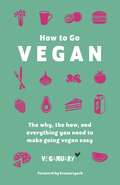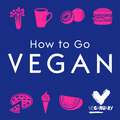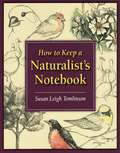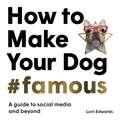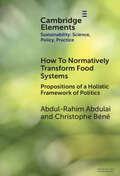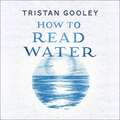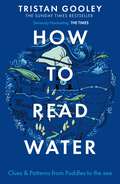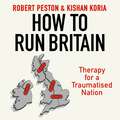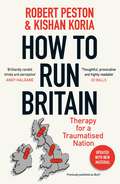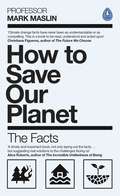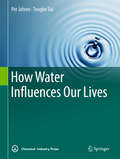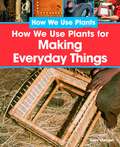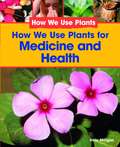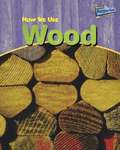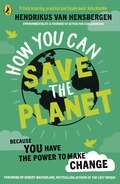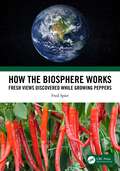- Table View
- List View
How To Go Vegan: The why, the how, and everything you need to make going vegan easy
by VeganuaryEver thought about eating less meat and fewer dairy products? Concerned about animal welfare and the environment? Interested in the health benefits of a plant-based lifestyle? This is the book for you. In this fun, easy to follow and informative guide, the team behind the charity Veganuary provide everything you need to make changes towards leading a healthier, more ethical and sustainable lifestyle. From your motivations, tips for eating out, easy substitutions and making sure you get the right nutrients, this book is a lifesaver for vegans, those wanting to give veganism a try, or for friends and family. Try going vegan for one month - with How To Be Vegan it is easier than you think.
How To Go Vegan: The why, the how, and everything you need to make going vegan easy
by Veganuary Trading LimitedA short guide to going vegan - the why, the what and the how.Ever thought about eating less meat and fewer dairy products? Concerned about animal welfare and the environment? Interested in the health benefits of a plant-based lifestyle? This is the book for you. In this fun, easy to follow and informative guide, the team behind the charity Veganuary provide everything you need to make changes towards leading a healthier, more ethical and sustainable lifestyle. From your motivations, tips for eating out, easy substitutions and making sure you get the right nutrients, this book is a lifesaver for vegans, those wanting to give veganism a try, or for friends and family. Try going vegan for one month - with How To Be Vegan it is easier than you think.(P)2017 Hodder & Stoughton
How To Keep A Naturalist's Notebook
by Susan Leigh TomlinsonA one-of-a-kind, art-filled how-to guide geared to wildlife students and naturalists, based on the author's college course. Pages from actual field notebooks clearly illustrate what works and why. Hints and advice for outdoorspeople with even limited artistic skills.
How To Make Your Dog #Famous: A Guide to Social Media and Beyond
by Loni EdwardsYou know your dog is the cutest but does everyone else know it too?In this book, Loni Edwards, the human behind the world's most influential pets, breaks down the path to fame. Discover insights into the success of social media's top pups and follow the essential steps on the road to fame - from crafting your brand to advocating for your pup on set. With expert guidance on how to be a good dog parent and make sure your pup is happy and healthy every step of the way, this is your one-stop guide to helping your dog win over hearts, one adorable post at a time.Featuring the stories of more than 40 of the most successful pet influencers:157 of Gemma, Amazing Graciedoodle, Barkley Sir Charles, Bertie Bert the Pom, Bronson the Bully, Brussels Sprout, Bully Baloo, Charlie the Black Shepherd, Chloe the Mini Frenchie (& Emma Bear), Coco the Maltese Dog (Coco & Cici), Cookie Malibu, Crusoe the Celebrity Dachshund, Daily Dougie, Dog named Stella, Ducky the Yorkie, Frame the Weim, Gone to the Snow Dogs, Harlow and Sage, Hi Wiley, Kelly Bove, Lilybug, Lizzie Bear, Louboutina the Hugging Dog, Maya Polar Bear, Mervin the Chihuahua, Milo and Noah, MJ the Beagle, Mr. Biggie, Popeye the Foodie, Puggy Smalls, Reagandoodle, Remix the Dog, Rocco Roni, Super Corgi Jojo, Super Scooty, Tatum, That Goldendoodle, The Bike Dog, Tika the Iggy, Tuna Melts my Heart, Tupey the Borzoi, Verpinscht, Winnie the Cocker, Wolfgang 2242
How To Make Your Dog #Famous: A Guide to Social Media and Beyond
by Loni EdwardsYou know your dog is the cutest but does everyone else know it too?In this book, Loni Edwards, the human behind the world's most influential pets, breaks down the path to fame. Discover insights into the success of social media's top pups and follow the essential steps on the road to fame - from crafting your brand to advocating for your pup on set. With expert guidance on how to be a good dog parent and make sure your pup is happy and healthy every step of the way, this is your one-stop guide to helping your dog win over hearts, one adorable post at a time.Featuring the stories of more than 40 of the most successful pet influencers:157 of Gemma, Amazing Graciedoodle, Barkley Sir Charles, Bertie Bert the Pom, Bronson the Bully, Brussels Sprout, Bully Baloo, Charlie the Black Shepherd, Chloe the Mini Frenchie (& Emma Bear), Coco the Maltese Dog (Coco & Cici), Cookie Malibu, Crusoe the Celebrity Dachshund, Daily Dougie, Dog named Stella, Ducky the Yorkie, Frame the Weim, Gone to the Snow Dogs, Harlow and Sage, Hi Wiley, Kelly Bove, Lilybug, Lizzie Bear, Louboutina the Hugging Dog, Maya Polar Bear, Mervin the Chihuahua, Milo and Noah, MJ the Beagle, Mr. Biggie, Popeye the Foodie, Puggy Smalls, Reagandoodle, Remix the Dog, Rocco Roni, Super Corgi Jojo, Super Scooty, Tatum, That Goldendoodle, The Bike Dog, Tika the Iggy, Tuna Melts my Heart, Tupey the Borzoi, Verpinscht, Winnie the Cocker, Wolfgang 2242
How To Normatively Transform Food Systems: Propositions of a Holistic Framework of Politics (Elements of Sustainability: Science, Policy, Practice)
by Christophe Béné Abdul-Rahim AbdulaiDraws from an extensive literature review on food politics to propose a Framework of Holistic Politics for Food System Transformation. The Framework posits that food systems transformation would be a process/outcome of interrelated political configurations of actions across four processes or stages: 1) Identifying resistance to change in the current regime, 2) Creating and sustaining new momentum, 3) Converting new momentum into sustainable options; -and cross-cutting, 4) Managing trade-offs, reducing incoherence, and prioritization. At each stage, four domains of politics must be considered, including 1) Power, the political economy of actors, knowledge, and evidence; 2) Cultural dynamics, norms, and behavior; 3) Capacity and financial resources; and 4) Technological innovations). To deliver normative transformation, these actions must be carried out in four distinct processes. The Framework underscores the need for normative and goal-oriented processes, the multi-dimensionality of politics, and the normative driving environment in governance food systems transformation.
How To Read Water: Clues & Patterns from Puddles to the Sea
by Tristan GooleyA Sunday Times 'Must Read' book'This study of rivers, lakes, puddles and seas brims over with astonishing facts...His observational skills can be breathtaking' The Sunday TimesA must-have book for walkers, sailors, swimmers, anglers and everyone interested in the natural world, in How To Read Water, Natural Navigator Tristan Gooley shares knowledge, skills, tips and useful observations to help you enjoy the landscape around you. Includes over 700 clues, signs and patterns. You'll learn how to:Interpret ponds like a PolynesianSpot dangerous water in the pitch black with the help of a clock faceRead the sea like a VikingForecast the weather from wavesFind your way with puddlesDecipher wave patterns on beachesDecode the colour of waterUnravel a river like an expertFrom wild swimming in Sussex to wayfinding off Oman, via the icy mysteries of the Arctic, Tristan Gooley draws on his own pioneering journeys to reveal the secrets of ponds, puddles, rivers, oceans and more to show us all the skills we need to read the water around us.(P)2016 Hodder & Stoughton
How To Read Water: Clues & Patterns from Puddles to the Sea (Natural Navigation Ser.)
by Tristan GooleyFrom the bestselling author of THE WALKER'S GUIDE TO OUTDOOR CLUES AND SIGNSA must-have book for walkers, sailors, swimmers, anglers and everyone interested in the natural world, in How To Read Water, Natural Navigator Tristan Gooley shares knowledge, skills, tips and useful observations to help you enjoy the landscape around you and learn about the magic of the outdoors from your living room.Includes over 700 clues, signs and patterns. From wild swimming in Sussex to wayfinding in Oman, via the icy mysteries of the Arctic, Tristan Gooley draws on his own pioneering journeys to reveal the secrets of ponds, puddles, rivers, oceans and more to show us all the skills we need to read the water around us.
How To Run Britain: Therapy For A Traumatised Nation
by Robert PestonTHE MUST-READ BOOK FROM ITV'S ROBERT PESTON AND KISHAN KORIA, REVISED AND UPDATED FOLLOWING THE GENERAL ELECTION *Previously published as Bust?*---------Britain is facing uncertainty, threats and risk: new Prime Minister, new government, new political landscape, at home and abroad. But how much should change? And how much will change?How To Run Britain is a plea from Robert Peston and Kishan Koria to own what's gone wrong and make courageous reforms to everything, from the way we manage the economy to how we vote. We all know that, over the past fifteen years, British living standards have stagnated, inequality between - and within - communities has grown rampant, politicians have lost credibility and the trust of the nation. Millions say they are unheard and disenfranchised, victimised even. A far-right racist minority feels entitled to riot. But what do those problems really mean - and how do we fix them? How can politicians win the trust back from voters, from teachers, doctors, students, pensioners - all those who feel left behind by those who purport to act in their best interest?Peston and Koria's argument is simple: first, we must interrogate everything that has gone wrong, and build solutions from there. This is not the time to shy away from the recent past, nor should we indulge in it. Instead, we should take the lessons learned over the past fifteen years and build a future-focused, strategic plan for restoring economic, political and social security to the country we know and love.How To Run Britain is a manifesto for change in its simplest, clearest form, from the minds of two people who have seen it all.This is an updated, retitled edition of Bust? by Robert Peston and Kishan Koria, published in 2023.
How To Run Britain: Therapy For A Traumatised Nation
by Robert PestonTHE MUST-READ BOOK FROM ITV'S ROBERT PESTON AND KISHAN KORIA, REVISED AND UPDATED FOLLOWING THE GENERAL ELECTION *Previously published as Bust?*---------Britain is facing uncertainty, threats and risk: new Prime Minister, new government, new political landscape, at home and abroad. But how much should change? And how much will change?How To Run Britain is a plea from Robert Peston and Kishan Koria to own what's gone wrong and make courageous reforms to everything, from the way we manage the economy to how we vote. We all know that, over the past fifteen years, British living standards have stagnated, inequality between - and within - communities has grown rampant, politicians have lost credibility and the trust of the nation. Millions say they are unheard and disenfranchised, victimised even. A far-right racist minority feels entitled to riot. But what do those problems really mean - and how do we fix them? How can politicians win the trust back from voters, from teachers, doctors, students, pensioners - all those who feel left behind by those who purport to act in their best interest?Peston and Koria's argument is simple: first, we must interrogate everything that has gone wrong, and build solutions from there. This is not the time to shy away from the recent past, nor should we indulge in it. Instead, we should take the lessons learned over the past fifteen years and build a future-focused, strategic plan for restoring economic, political and social security to the country we know and love.How To Run Britain is a manifesto for change in its simplest, clearest form, from the minds of two people who have seen it all.This is an updated, retitled edition of Bust? by Robert Peston and Kishan Koria, published in 2023.
How To Run Britain: Therapy For A Traumatised Nation
by Robert PestonTHE MUST-READ BOOK FROM ITV'S ROBERT PESTON AND KISHAN KORIA, REVISED AND UPDATED FOLLOWING THE GENERAL ELECTION *Previously published as Bust?*---------Britain is facing uncertainty, threats and risk: new Prime Minister, new government, new political landscape, at home and abroad. But how much should change? And how much will change?How To Run Britain is a plea from Robert Peston and Kishan Koria to own what's gone wrong and make courageous reforms to everything, from the way we manage the economy to how we vote. We all know that, over the past fifteen years, British living standards have stagnated, inequality between - and within - communities has grown rampant, politicians have lost credibility and the trust of the nation. Millions say they are unheard and disenfranchised, victimised even. A far-right racist minority feels entitled to riot. But what do those problems really mean - and how do we fix them? How can politicians win the trust back from voters, from teachers, doctors, students, pensioners - all those who feel left behind by those who purport to act in their best interest?Peston and Koria's argument is simple: first, we must interrogate everything that has gone wrong, and build solutions from there. This is not the time to shy away from the recent past, nor should we indulge in it. Instead, we should take the lessons learned over the past fifteen years and build a future-focused, strategic plan for restoring economic, political and social security to the country we know and love.How To Run Britain is a manifesto for change in its simplest, clearest form, from the minds of two people who have seen it all.This is an updated, retitled edition of Bust? by Robert Peston and Kishan Koria, published in 2023.
How To Save Our Planet: The Facts
by Mark A. Maslin'Punchy and to the point. No beating around the bush. This brilliant book contains all the information we need to have in our back pocket in order to move forward' Christiana Figueres, Former Executive Secretary UN Climate Change Convention'Amazing book' Chris Evans, Virgin Radio Breakfast Show'Everyone should have this book' Rick Edwards, BBC Radio 5 Live'A timely and important book, not only laying out the facts...but suggesting real solutions to the challenges facing us' Professor Alice Roberts, Anatomist, Professor of Public Engagement in Science, University of Birmingham_________________________ How can we save our planet and survive the 21st century? How can you argue with deniers? How can we create positive change in the midst of the climate crisis? Professor Mark Maslin has the key facts that we need to protect our future. Global awareness of climate change is growing rapidly. Science has proven that our planet and species are facing a massive environmental crisis. How to Save Our Planet is a call to action, guaranteed to equip everyone with the knowledge needed to make change. Be under no illusion the challenges of the twenty-first century are immense. We need to deal with: climate change, environmental destruction, global poverty and ensure everyone's security. We have the technology. We have the resources. We have the money. We have the scientists, the entrepreneurs and the innovators. We lack the politics and policies to make your vision of a better world happen. So we need a plan to save our planet... How to Save Our Planet is your handbook of how we together can save our precious planet. From the history of our planet and species, to the potential of individuals and our power to create a better future, Maslin inspires optimism in these bleak times. We stand at the precipice. The future of our planet is in our hands. It's time to face the facts and save our planet from, and for, ourselves._________________________'A handbook of clearly established, authoritative facts and figures about the terrible toll we as humans have taken of our planet, plus ways in which we can lessen the impact. For laypeople like me, who can see what is happening but haven't always got the precise statistics to hand, it's hugely valuable' John Simpson CBE, BBC World Affairs Editor, Broadcaster, Author & Columnist'Saving the world is no small thing, but picking up this book's a good start' Paris Lees, Contributing Editor at British Vogue, campaigner'I love it. My kids love it' Chris Evans, Virgin Radio Breakfast Show'A no-nonsense crib sheet on the state of the world and how to help it' The I Newspaper
How Water Influences Our Lives
by Per Jahren Tongbo SuiThis beautifully illustrated book explains how water influences our culture; the many phases of water from ice to gas, its simple but still so unpredictable nature, and water resources on Earth; how water is distributed in ice, oceans, rivers, lakes and more; how it creates transport possibilities; how it produces and absorbs energy; how it is constantly changing the surface of the Earth; how there is enough water on Earth, yet sometimes there is too much or too litt≤ the role of water in recreation; and how water supplies us with food in a myriad of ways. Few things are like water - a subtle and thought-provoking element, so simple and yet complicated, so conspicuous yet unpredictable, so soft and peaceful yet powerful, and so universal yet unique. Water is by far the world's largest commodity. Though it belongs to all of us, it is still not shared by all. We very seldom take time to reflect on the many ways that water affects our lives. Though it would be too ambitious to believe that it claims all the meanings and roles of water, this book, by showcasing water's versatility and by sharing the experiences and insights gained by the two authors during their many travels across the globe, contributes to a greater awareness of the most important substance in our society - water. The book offers an insightful and intriguing read for anyone interested in science and culture related to water, from laymen to students and decision-makers.
How We Can Save the Planet: Preventing Global Climate Catastrophe
by Tina Fawcett Mayer Hillman Sudhir Chella RajanAn outstanding overview on global warming---and what we can do about it---from a distinguished world-class authorityClimate change is the single biggest problem that humankind has ever had to face, as we continue with lifestyles that are way beyond the planet's limits. In this book Mayer Hillman explains the real issues: what role technology can play, how you and your community can make changes, and why governments must act now to protect our planet for later generations. How We Can Save the Planet: Preventing Global Climate Catastrophe takes us out of the problem and into the solution of our global crisis.
How We Know What We Know about Our Changing Climate: Scientists and Kids Explore Global Warming
by Lynne CherryWhen the weather changes daily, how do we really know that Earth's climate is changing? Here is the science behind the headlines - evidence from flowers, butterflies, birds, frogs, trees, glaciers and much more, gathered by scientists from all over the world, sometimes with assistance from young "citizen-scientists." And here is what young people, and their families and teachers, can do to learn about climate change and take action. Climate change is a critical and timely topic of deep concern, here told in an age-appropriate manner, with clarity and hope. Kids can make a difference!
How We Use Plants for Food
by Sally MorganPlants are used to make so many foods that we eat! This title engages readers with easy do-it-yourself experiments as it explains the many fascinating ways plants can be made into food; from cereal, fruits and vegetables, to sugar and oils. Different parts of the plant are used to make these foods; and freshness and preservation are equally important.
How We Use Plants for Making Everyday Things
by Sally MorganMany of the things we use each day are made from plants. Readers may not realize that the clothes they wear or the rubber tires on their bicycle are made from plants. This book covers plant-based items from fabrics to paper. Students will have the opportunity to participate in the process as they learn how to make their own paper!
How We Use Plants for Medicine and Health
by Sally MorganPeople use plants for a variety of medicinal and health purposes from making herbal remedies and pain killers, to products for skin care and healthy teeth to fighting diseases like cancer. Readers will also have the chance to make their own plant remedy.
How We Use Wood
by Chris OxladeHow We Use Wood will give you answers to these and many other questions: Why is wood a good material for building boats? How do we get paper from wood? Why we use wood to make drain pipes?
How You Can Save the Planet
by Hendrikus van Hensbergen*Foreword by Robert Macfarlane, bestselling author of The Lost Words.*If you're worried about climate change, this book is an essential and reassuring read.We often feel like we don't have the power to make real change.But our small changes can add up to something BIG. Packed with reassuring step by step actions and easy to follow DIY activities, How You Can Save The Planet is the perfect gift for young activists who want to make a difference.With simple explanations, practical tips and stories from children across the world, this guide is ideal for young people who are worried about climate change and want to help our planet!Crafted by Hendrikus van Hensbergen, whose work is featured on BBC Bitesize[JP2] , this inspiring read is perfect for children at KS2. 'Every young person in the country should be given this book' Sir Tim Smit, Founder of The Eden Project'It's enlightening, inspiring and empowering' Kate Humble, TV presenter'Wonderfully informative, fun and practical [. . .] A great source of inspiration' The Rich Brothers, TV presenters
How a City Works (Let's-Read-and-Find-Out Science 2)
by D. J. WardRead and find out about how cities work in this colorfully illustrated nonfiction picture book.Millions of people live in cities around the world, but have you ever wondered how cities work? All those people need clean water to drink, a safe place to live, and a way to get all around the city. How do you take care of all those people’s needs? Read and find out all about the systems a city has to help keep everyone safe, healthy, and happy.This book on city systems will appeal to the young civil engineer. How a City Works is filled with fun, accurate art, and includes tons of information. For example, it answers the question: Where does all the electricity needed to make a city run come from? How a City Works covers water treatment, power, sewage, recycling, and transportation.How a City Works comes packed with visual aids like charts, sidebars, an infographic, and a funny, hands-on activity—how to clean up dirty “sewage” water, using puffed rice cereal, raisins, hot chocolate mix, and coffee filters.This is a clear and appealing science book for early elementary age kids, both at home and in the classroom. It's a Level 2 Let's-Read-and-Find-Out, which means the book explores more challenging concepts for children in the primary grades. The 100+ titles in this leading nonfiction series are:hands-on and visualacclaimed and trustedgreat for classroomsTop 10 reasons to love LRFOs:Entertain and educate at the same timeHave appealing, child-centered topicsDevelopmentally appropriate for emerging readersFocused; answering questions instead of using survey approachEmploy engaging picture book quality illustrationsUse simple charts and graphics to improve visual literacy skillsFeature hands-on activities to engage young scientistsMeet national science education standardsWritten/illustrated by award-winning authors/illustrators & vetted by an expert in the fieldOver 130 titles in print, meeting a wide range of kids' scientific interestsBooks in this series support the Common Core Learning Standards, Next Generation Science Standards, and the Science, Technology, Engineering, and Math (STEM) standards. Let's-Read-and-Find-Out is the winner of the American Association for the Advancement of Science/Subaru Science Books & Films Prize for Outstanding Science Series.
How a Seed Grows (Let's-Read-and-Find-Out Science 1)
by Helene J. JordanRead and find out about how a tiny acorn grows into an enormous oak tree in this colorfully illustrated nonfiction picture book.This is a clear and appealing environmental science book for early elementary age kids, both at home and in the classroom. Plus it includes a find out more activity section with a simple experiment encouraging kids to discover what a seed needs to grow.This is a Level 1 Let's-Read-and-Find-Out, which means the book explores introductory concepts perfect for children in the primary grades. The 100+ titles in this leading nonfiction series are:hands-on and visualacclaimed and trustedgreat for classroomsTop 10 reasons to love LRFOs:Entertain and educate at the same timeHave appealing, child-centered topicsDevelopmentally appropriate for emerging readersFocused; answering questions instead of using survey approachEmploy engaging picture book quality illustrationsUse simple charts and graphics to improve visual literacy skillsFeature hands-on activities to engage young scientistsMeet national science education standardsWritten/illustrated by award-winning authors/illustrators & vetted by an expert in the fieldOver 130 titles in print, meeting a wide range of kids' scientific interestsBook in this series support the Common Core Learning Standards, Next Generation Science Standards, and the Science, Technology, Engineering, and Math (STEM) standards. Let's-Read-and-Find-Out is the winner of the American Association for the Advancement of Science/Subaru Science Books & Films Prize for Outstanding Science Series.
How a plant grows (Crabapples)
by Bobbie KalmanHow A Plant Grows introduces children to the amazing lives of plants--from their beginnings, through their growth, to reproduction and death. Full-color illustrations and photographs accompany simple plant experiments.
How the Biosphere Works: Fresh Views Discovered While Growing Peppers
by Fred SpierHow the Biosphere Works: Fresh Views Discovered While Growing Peppers offers a simple and novel theoretical approach to understanding the history of the biosphere, including humanity’s place within it. It also helps to clarify what the possibilities and limitations are for future action. This is a subject of wide interest because today we are facing a great many environmental issues, many of which may appear unconnected. Yet all these issues are part of our biosphere. For making plans for the future and addressing our long-term survival and well-being, an integrated knowledge of our biosphere and its history is therefore indispensable. Key Features Documents what the biosphere is, and what our position as humans within it is today. Describes how the biosphere has become the way it is. Summarizes the novel simple theoretical model proposed in the book, and thus, how the biosphere functions. Predicts what the possibilities and limitations are for future human action Emphasizes how simple but careful observations can lead to far-reaching theoretical implications.
How the California Electricity Crisis Generated a Green Wave: An Insider's Account (Routledge Environmental History)
by Kurt SchuparraThis book provides the definitive account of a decade-long transformation of energy policy in California with rippling consequences. The author, a state government “insider” during much of this period, tells a story informed by personal experience, access to the key actors of the time (both then and now), and extensive research.California’s risky experiment in deregulating the state’s electricity market in the 1990s, resulting in manipulation from unscrupulous energy providers and necessitating government action, laid the foundation for a greener grid and greater energy efficiency in the early 2000s and beyond. The book follows the state’s energy journey through Democratic Governor Gray Davis’s administration and his Republican successor Arnold Schwarzenegger’s time in office, providing a detailed behind-the-scenes account. It highlights how this period influenced broader discussions of energy policy in the U.S., culminating in President Barack Obama pledging bold action and securing $90 billion for clean energy programs in the 2009 “stimulus” bill, the largest single “green” investment in history at that point in time. The energy crisis provided a springboard for green growth by discrediting deregulation, elevating public support, and establishing a political pathway for a growing array of sustainable energy advocates.This book engagingly balances policy considerations and political drama to reveal the untold details of how the electricity crisis paved the way for key climate and clean energy policies and offers unprecedented access to archival material from the Davis administration era. It will be a must-read for energy policymakers, researchers, and environmental historians.
